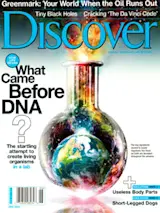The question took me by surprise. I was sitting in a noisy Boston café with two biochemists who were having a straight-faced conversation about putting together a budget to create synthetic life-forms. Next to me was Jack Szostak of Harvard Medical School, and across the table was Steven Benner, who had flown up from the University of Florida to pay Szostak a visit. The conversation was thrumming along, touching on the efficiencies of chemical reactions and the like, when Benner abruptly turned to me and asked, “How much do you think it would cost to create a self-replicating organism capable of Darwinian evolution?”
The question was not “Will we ever create life?” but simply how much money creating life would cost. “Twenty million dollars,” I said, choosing the number completely at random.
Benner nodded. “That’s what Jack says.”
Szostak, whose large glasses and round face make him look like an ...














